
Lecture index: Wilcox et. al. (1973) predictive model. / Locking and restraining bends. / Transpression, transtension and flower structures. / Models of decoupling. / Examples of major transcurrent zones. /
Readings:
Chapt. 18 in Fossen, Structural Geology, Cambridge Press.
Ben-Avraham, Z. & Zoback, M. D., 1992, Transform-normal extension and symmetric basins: An alternative to pull-apart models; Geology, v. 20, p. 423-426
Key terms and concepts:
Some related terminology:
This model enjoys experimental, theoretical. and some empirical success.
2 basic assumptions:
Basic question is how can elongation of major strain ellipse axis and shortening of minor axis be accommodated by distinct structures (inhomogenous deformation)? One can think of an underlying ductile shear zone with a major component of simple shear influencing the pattern of brittle structures in the overlying crust.
Possible to form the following sets of en echelon features in isolation or combination:

Assemblage of idealized structures that are predicted to accommodate shortening and extension in a zone of simple shear where deformation is inhomogenous and results in discrete structures.
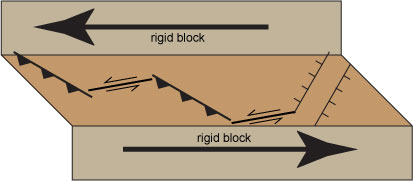
Cartoon example of more complex pattern formed by linking various of the en echelon structures that can be formed. In this way wrench zones and large strike-slip faults such as the San Andreas can change their character significantly as they are traced along strike.

Take this basic scenario through an evolution and get significant complexity. Key aspect of this is rotation component. Again, faults can rotate out of an appropriate position for slip and new faults develop.
Clay modeling video of development of en echelon features in wrench setting: http://wn.com/Strike_slip_analogue_model_experiment_GUtech_@_RWTH_Aachen
Some problems and shortcomings associated with this model:
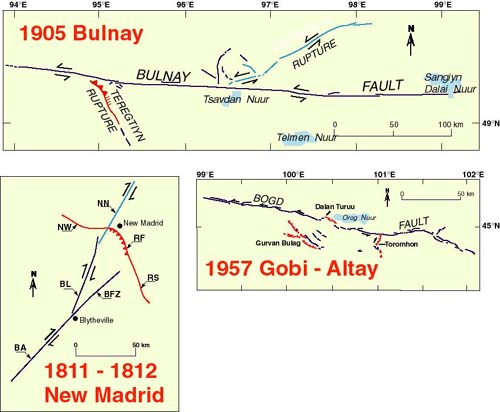
Another example of a fault bend geometry that again causes fault block strain, but without the hanging vs. footwall distinction. Basically the block movement vector is at an angle to the slip plane/fault zone so that there is a material gap or overlap to be accommodated, translating to an extensional or contractional component to deformation. These can also be thought of as relay or transfer zones.
This geometry can be seen at a variety of scales.
It may originate from:
For large enough scale (lithospheric) then can a locking bend is transpressive and a releasing bend is transtensive.
Major strike-slip zones often characterized by significant geometric and kinematic change along strike - that very complexity can be a distinctive trait.
Defined in cross section perspective:
Flower structures as local shallow strike-slip duplexes.

Positive and negative flower structure. Source: http://earthquake.usgs.gov/research/creep/GardeniaEE_crax.html
The basic idea is that if there are transpressional or transtensional conditions, an alternate response is to have the strike-slip and dip-slip components accommodated on separate but parallel structures. Instead of a positive flower structure you could have a parallel set of thrusts and vertical strike-slip faults. This can be approached from an energy perspective.
Decoupling is promoted when a very weak slip surface is involved. This can be a previously existing surface or develop with deformation.
This behavior had been modeled in laboratory studies.
Oblique subduction zones often shows this behavior at a large scale.
When should decouping occur? Neglecting the ductile and weaker crust below and focusing on the brittle portion, one can set up an equality for the energy required to move obliquely on one dipping surface, versus the energy required to move on both surfaces, in a dip slip direction on the dipping fault, and in a strike-slip direction on the vertical fault. A key consideration will be the relative shear strengths of the surfaces. The force required will be equal to the area of the fault surface times the shear force times the distance moved. The following factors can then be seen to favor decoupling: a significantly weaker strike-slip zone, a low dip angle on the dipping fault, and a higher strike/dip slip motion ratio.
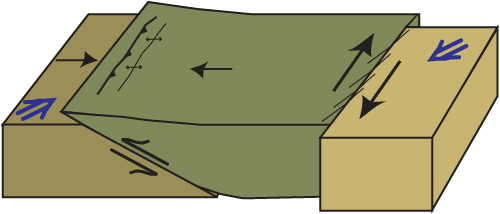
Schematic diagram of decoupling, where oblique motion between two larger crustal blocks, direction shown by large blue arrows, is partitioned into two subparallel but kinematically distinct belts. The dextral transpression across the deformation zone (green block) is split into a fold-thrust belt with boundary perpendicular contractional kinematics (to the left here), and a boundary parallel dextral component (to the right).
New Zealand's Alpine fault
Displacement amounts:
There are en echelon folds developed and oblique motion on the main fault - can consider it a coupled or only partially decoupled system system.
Note northern faults forming - more pure transcurrent. Why? as thicken crust resistance increases, and more energy efficient to form new crust?
Movement history?
Along strike kinematics change (north to south):
SAFOD and stresses along the San Andreas - http://earthquake.usgs.gov/research/parkfield/safod_pbo.php.
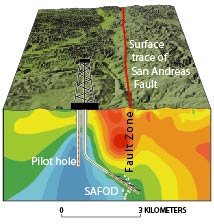
Anomalies associated with the San Andreas fault that need to be explained:
Model of decoupling and very low strength faults (e.g. Mount & Suppe, 1987).
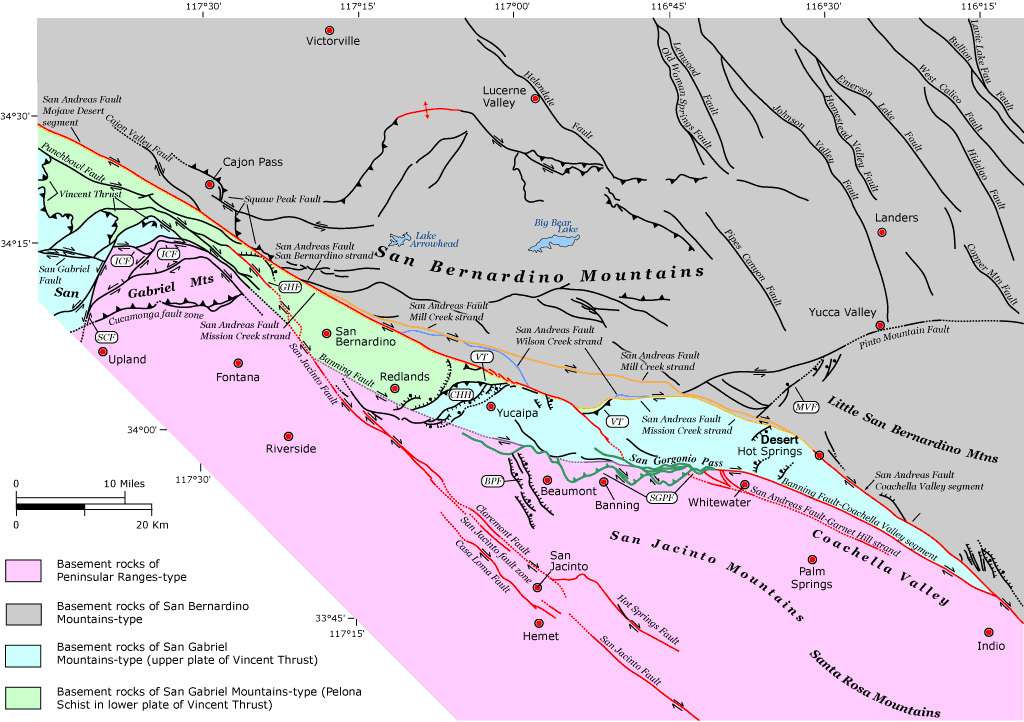
Dead Sea Transform
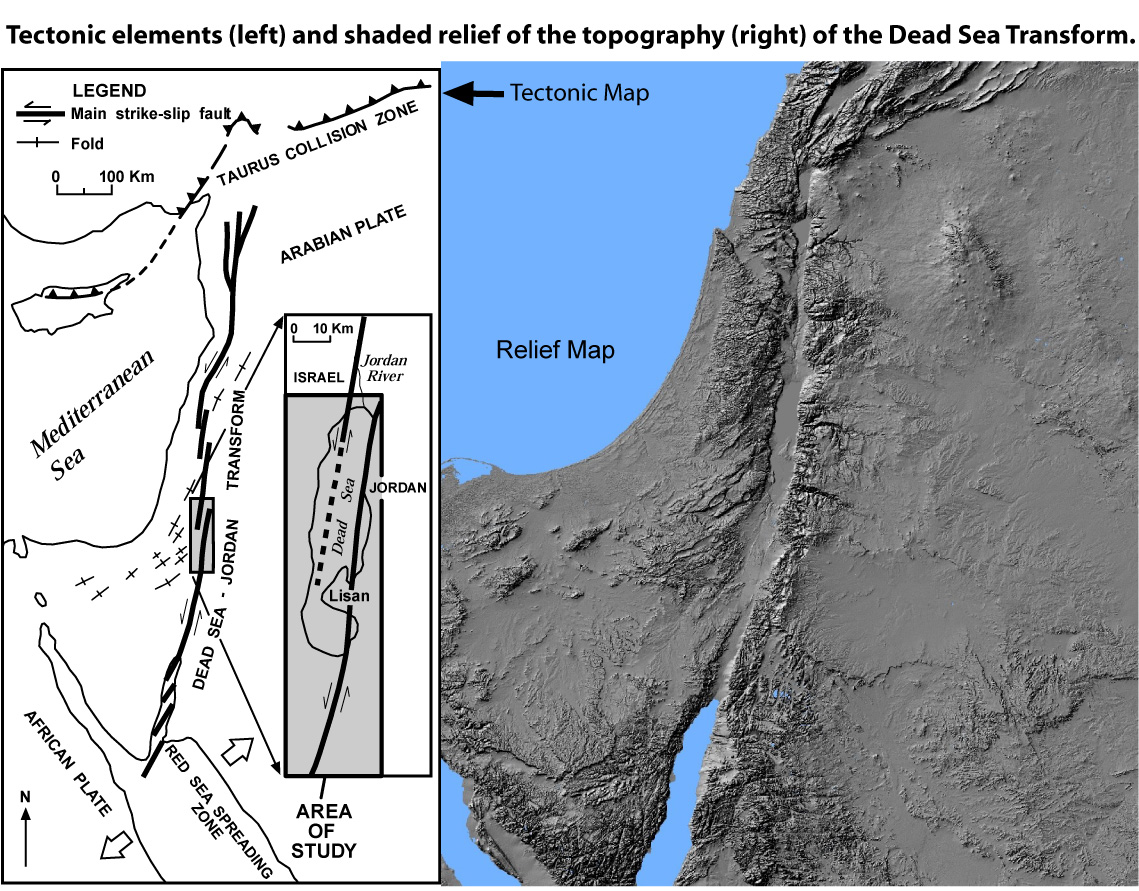
Image of the Dead Sea transform from USGS site, at Peace and Science in the Middle East at http://woodshole.er.usgs.gov/project-pages/dead_sea/tectonic.html.
EPFZ system in the southern Appalachians.
Additional references:
Copyright Harmon D. Maher Jr., This may be used for non-profit educational purposes as long as proper attribution is given. Otherwise, please contact me. Thank you.